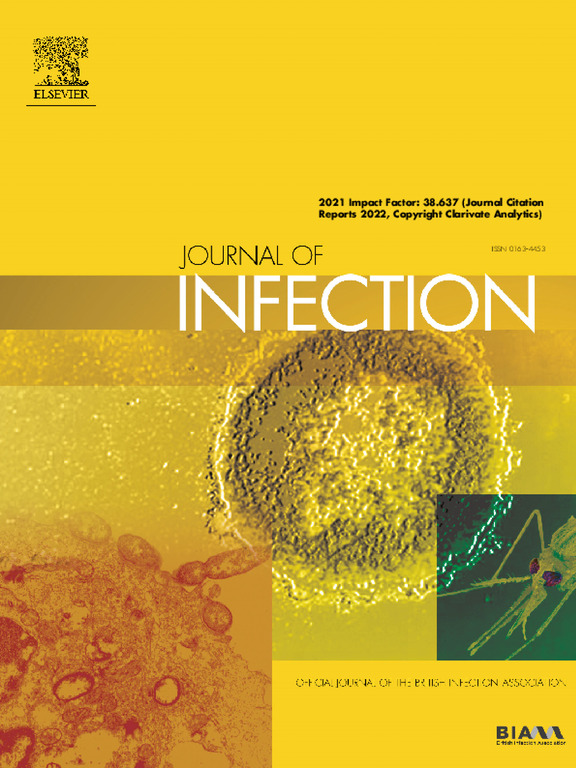噬菌体联合mNGS可提高细菌感染诊断的特异性。
IF 11.9
1区 医学
Q1 INFECTIOUS DISEASES
引用次数: 0
摘要
新一代宏基因组测序(mNGS)是加强感染患者病原体检测的重要工具。然而,区分感染或定植的标本仍然是一项重大挑战。目的:探讨人体血液和呼吸道中噬菌体的组成,噬菌体检测与细菌感染的关系,以及根据mNGS结果,噬菌体是否能协助鉴别感染性病原体。方法:收集2023年1月至2024年2月住院患者的临床样本。从BALF和血浆中回顾性提取DNA和游离DNA,鉴定存在的病原体,并进行噬菌体注释。结果:218例患者共获得299份样本,其中血液样本136份,BALF样本163份。与细菌阴性的样本相比,感染鲍曼不动杆菌、肺炎克雷伯菌、铜绿假单胞菌和金黄色葡萄球菌的血液和支气管肺泡灌洗液(BALF)样本显示,与这些病原体相关的噬菌体比例相应增加。在鲍曼不动杆菌感染的BALF样本中,自噬病毒科、虹膜病毒科和肌病毒科的比例显著高于鲍曼不动杆菌定殖组。肌病毒科区分感染与定植的敏感性为86.36%,特异性为52.94%。结论:在脓毒症中,与单独使用常规mNGS方法相比,噬菌体联合mNGS方法对病原菌的识别更有效,特异性更高。这些发现可能为提高临床感染诊断水平提供新的思路和工具。本文章由计算机程序翻译,如有差异,请以英文原文为准。
Bacteriophage combined with mNGS enhances the specificity of bacterial infection diagnosis
Introduction
Metagenomic next-generation sequencing (mNGS) is an important tool for enhancing pathogen detection in infected patients. However, distinguishing between specimens that are infected or colonized is still a major challenge.
Objectives
To explore the composition of bacteriophages in the blood and respiratory tract of the human body, the association between bacteriophage detection and bacterial infections, and whether bacteriophages can assist in differentiating infectious pathogens according to mNGS results.
Methods
Clinical samples from hospitalized patients were collected between January 2023 and February 2024. DNA and cell-free DNA were extracted from BALF and plasma retrospectively to identify the pathogens present, and bacteriophage annotations were conducted.
Results
A total of 299 samples, comprising 136 blood samples and 163 BALF samples, were obtained from 218 patients. Compared with the samples negative for bacteria, both blood and bronchoalveolar lavage fluid (BALF) samples infected with Acinetobacter baumannii, Klebsiella pneumoniae, Pseudomonas aeruginosa, and S. aureus showed a corresponding increase in the proportions of phages related to these pathogens. In BALF samples with Acinetobacter baumannii infection, the proportions of Autographiviridae, Siphoviridae, and Myoviridae were significantly greater than those in the Acinetobacter baumannii colonization group. The sensitivity of Myoviridae for differentiating between infection and colonization was 86.36%, and the specificity was 52.94%.
Conclusion
In sepsis, compared with conventional mNGS methods alone, the use of bacteriophages combined with mNGS was more effective in identifying causative pathogens and had higher specificity. These findings may provide new ideas and tools for improving clinical infection diagnosis.
求助全文
通过发布文献求助,成功后即可免费获取论文全文。
去求助
来源期刊

Journal of Infection
医学-传染病学
CiteScore
45.90
自引率
3.20%
发文量
475
审稿时长
16 days
期刊介绍:
The Journal of Infection publishes original papers on all aspects of infection - clinical, microbiological and epidemiological. The Journal seeks to bring together knowledge from all specialties involved in infection research and clinical practice, and present the best work in the ever-changing field of infection.
Each issue brings you Editorials that describe current or controversial topics of interest, high quality Reviews to keep you in touch with the latest developments in specific fields of interest, an Epidemiology section reporting studies in the hospital and the general community, and a lively correspondence section.
 求助内容:
求助内容: 应助结果提醒方式:
应助结果提醒方式:


